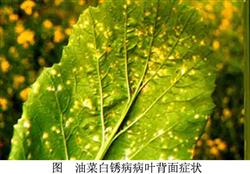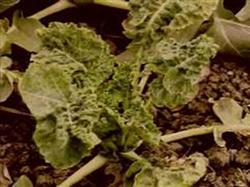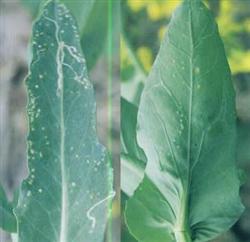When transplanting rape board stubble, we should take care of the five hurdles.

First, raising seedlings. ⑴ prepares enough seedbeds. According to the requirements of raising strong seedlings, the ratio of seedling bed to field is 1:6, and mature organic fertilizer is increased on the basis of sufficient seedling bed. 50 kg of compound fertilizer and 1 kg of borax are applied per mu, and then shallow spin into the soil after application. Fine ground preparation, the border surface is made into the shape of tortoise back, and a good drainage ditch is opened around the seedbed. ⑵ should be broadcast sparsely at the right time. Sparse sowing and sparse breeding is the key to cultivate strong seedlings. In order to make full use of the temperature and light resources before winter, the local suitable sowing date is September 12-15, and the sowing amount is strictly controlled during the suitable sowing period, and the sowing amount per mu of seedling bed is actually controlled between 0.5-0.75 kg. ⑶ will be in charge as soon as it is broadcast. The post-sowing management is mainly in the 1-leaf period, and the fixed seedlings in the three-leaf stage are weak, strong and pure, leaving 15-16 seedlings per square foot. At the same time, 15% paclobutrazol was used for chemical control in the trefoil stage. Kuaishaling and imidacloprid were used to control cabbage green insects and aphids during seedling breeding. Second, fertilization is off. The field should apply sufficient base fertilizer, early seedling fertilizer, heavy bolting fertilizer and skillful flower fertilizer. The specific amount of fertilizer application is 45% compound fertilizer 20-25 kg, urea 5-10 kg and borax 1 kg per mu. Specific application methods: when digging ponds and transplanting rape, tap the pond, pour water or sprinkle it in the transplanting pond and mix with the soil (to avoid direct contact with the root); the seedling fertilizer applies 25-30kg ammonium bicarbonate per mu according to the growth; when transplanting rape with plate stubble, the amount of base fertilizer is relatively small, so bolting fertilizer should be applied early and re-applied, and the specific amount of urea should be 15-20kg per mu according to the growth. Flower fertilizer mainly promotes balanced growth and reduces flower angle shedding and shade angle. Generally, 2-3 kg of urea is applied per mu. Third, weeding. To achieve the combination of manual weeding and chemical weeding. Ploughing and weeding is carried out before winter to improve the soil temperature and enhance the cold resistance, which is conducive to safe overwintering. Herbicides are selected according to the grass phase for chemical removal in spring. 10.8% of high efficient cover grass energy should be selected for fields dominated by Gramineae weeds, and 6.9% for fields dominated by Gramineae and broad-leaved weeds. Fourth, disease prevention and insect control. 40% mites were used to control aphids before winter, 40% carbendazim and 10% imidacloprid were used to control Sclerotinia sclerotiorum and aphids in early flowering stage and 10% imidacloprid respectively, and 10% imidacloprid was used to control aphids for 2-3 times in the corner stage of rape. Fifth, open ditches and reduce stains. Timely excavation of internal and external trenches to reduce stains, promote root growth, reduce the occurrence of Sclerotinia disease and so on.
- Prev

Rape virus disease
[distribution and damage] there are different degrees of occurrence in various rape producing areas all over the country, and the disease is more serious in winter rape areas than in spring rape areas. The disease is caused by single or compound infection of turnip mosaic virus (TuMV), cucumber mosaic virus (CMV), tobacco mosaic virus (TMV) and rape mosaic virus (YMV). Generally, the production will be reduced by 20% by 3%.
- Next

Integrated control techniques of rape white rust
The pathogen of rape white rust is white rust, which is a common disease in rape and cruciferous vegetables in the Yangtze River valley, which is often associated with rape downy mildew on the same flower axis. Symptoms: all organs in the aboveground part of rape can be susceptible to disease during the whole growth period. There are small light green spots on the surface of the leaves, and then yellow.
Related
- The first cup of black tea in spring, the flavor and history of tea gardens in Kenya, Africa
- The computer can not only choose potatoes, but also grow tea rice. AI will grow winter oolong tea champion.
- It is not only the inflated tea bitten by insects, but also engraved with the four seasons tea in Beipu.
- The Oriental Beauty Tea Festival in Zhuxian County takes the stage at the weekend to experience the plus-size feast of oil tea.
- & quot; Oriental Beauty Tea & Exploration of Emei in Hsinchu, the hometown of quot;
- The new variety of strawberry "Tainong 1" dessert is the first choice with mellow aroma. Crimson gorgeous
- History of Tea in Taiwan: from Wild Inner Mountain to Export Tea Garden
- Two types of Taiwan Oriental Beauty Black Tea won the British three-Star Award for Childhood Tea Xiang Zhang Jiaqi changed from pilot to champion tea maker.
- Banana species and varieties: the planting history of Taiwan Xianren banana and dwarf banana is long, is banana disease resistant?
- Coffee planting Technology: Qianjie Coffee from Seedling to harvesting

